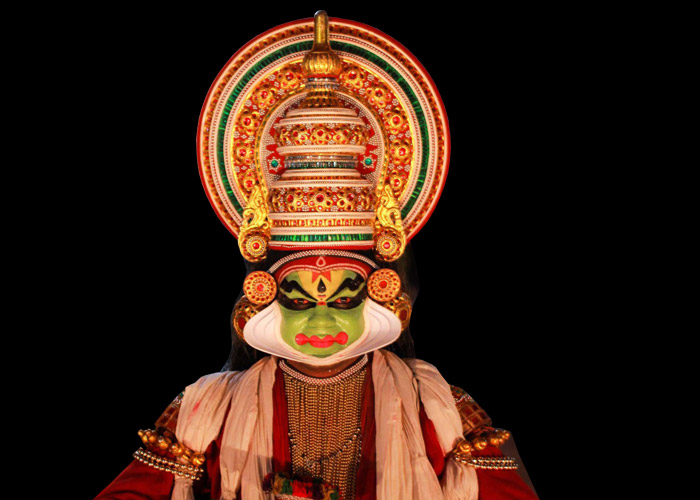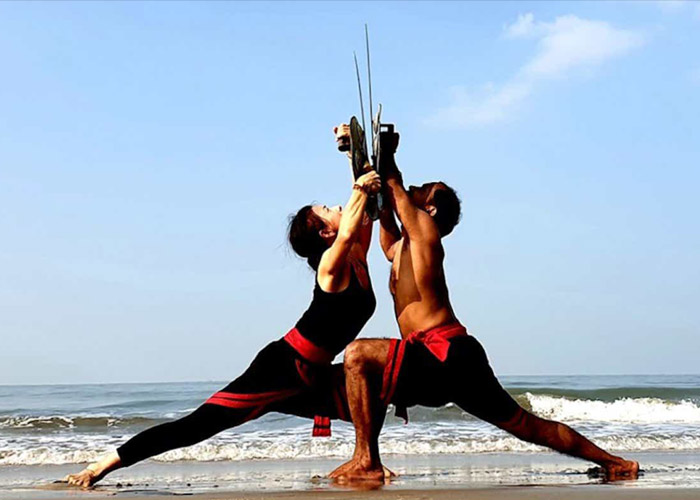Kerala Art forms
Kathakali

Kathakali dance, a mesmerising art form originating centuries ago in India, emerges as a captivating narrative dance that beautifully blends mudras, the graceful hand gestures portraying a character's dialogue, with bhava, the enchanting facial expressions that unveil the character's innermost emotions. It is a traditional form of classical Indian dance, and one of the most complex forms of Indian theatre. It is a "story play" genre of art, but one distinguished by the elaborately colorful make-up and costumes of the traditional male actor-dancers. It is native to the Malayalam-speaking southwestern region of Kerala and is entirely practiced by Malayali people. The fully developed style of Kathakali originated around the 16th century, but its roots are in the temple and folk arts. A Kathakali performance, like all classical dance arts of India, synthesizes music, vocal performers, choreography and hand and facial gestures together to express ideas. The vocal performance has traditionally been performed in Sanskritised Malayalam.
Koodiyattam

Koodiyattam is a traditional performing art form in the state of Kerala, India. It is a combination of ancient Sanskrit theatre with elements of Koothu, an ancient performing art from the Sangam era. It is officially recognised by UNESCO as a Masterpiece of the Oral and Intangible Heritage of Humanity. It is traditionally performed in temple theatres known as koothambalams. It is the only surviving art form that uses drama from ancient Sanskrit theatre. It has a documented history of a thousand years in Kerala, but its origins are not known. Koodiyattam and Chakyar koothu were among the dramatized dance worship services in the temples of ancient India, particularly Kerala. Traditionally, the main musical instruments used in koodiyattam are the mizhavu, kuzhitalam, edakka, kurumkuzhal, and sankhu. The name "koodiyattam", meaning playing or performing together, is thought to refer to the presence of multiple actors on stage who act in rhythm with the beats of the mizhavu drummers.
Mohiniyattam

Mohiniyattam is an Indian classical dance form originating from the state of Kerala.The dance gets its name from Mohini the female enchantress avatar of the Hindu deity Vishnu, who helps the devas prevail over the asuras using her feminine charm. Mohiniyattam's roots, like all classical Indian dances, are in the Natya Shastra – the ancient Hindu Sanskrit text on performance arts.The repertoire of Mohiniyattam includes music in the Carnatic style, singing and acting a play through the dance, where the recitation may be either by a separate vocalist or the dancer themselves. The song is typically in Malayalam-Sanskrit hybrid called Manipravalam.The dancer wears relatively simple jewelry and no masks, in contrast to the other major classical dance of Kerala called Kathakali. Her jewelry typically includes items on fingers, wrists, neck and ears (which may have bells. The musical instruments usually used in Mohiniyattam are Mridangam or Madhalam (barrel drum), Idakka (hour glass drum), flute, Veena, and Kuzhitalam (cymbals). The ragas (melody) are rendered in the sopana (steps) style, which is a slow melodic style with roots in the Natya Shastra.
Kalaripayattu

Kalaripayattu is also known as Kalari is an Indian martial art that originated in Kerala, a state on the southwestern coast of India during the 11th–12th century CE. Politically the land of Kerala was divided into a number of principalities and minor chieftaincies. The alignment and enmities of these power-centres resulted in constant warfare. Small scale skirmishes and large scale fighting were not uncommon among these local and regional authorities. In such a setup, each power centre was forced to maintain a body of fighters at its beck and call. Systematic training and strict rules of discipline for fighters were indispensable for an effective working of the system. It was in such circumstances that the body building and combat training provided by the Kalaris became not only necessary but essential.It is a five dimensional martial art with five different stages. Kalari is the space where a student practice and master the martial art, kalaripayattu. Traditional Kalari's follow specified shape, structure, dimensions and material for construction as per vaasthu. The architecture ensures the healing energy of the space by incorporating Panchamahabhutha theory. The Kalari is facing east-west, that allows the natural lighting and air flow.
Theyyam

In Kerala, Theyyam is performed predominantly in the North Malabar region, A similar custom known as Bhuta Kola is followed in the Tulunadu region of neighbouring Karnataka. Theyyam season starts from the tenth day of the Malayalam month of Thulam (usually falls during October, and known as paththaam-udayam) and lasts up to seven months till the middle of Edavam month (typically late May and June). The last Kaliyaattam for the season is performed at Madayi Kavu and Kalarivathukkal Bhagavathy Temple, both being the family shrines of Kolathiri royal family. Theyyam performances include the myths and stories of the many gods and celestial spirits in Kerala mythology, and its performers are vigilant and committed to guarding the purity of the art form and preserving its ritualistic heritage.Theyyam, believed to have been derived from the word Daivam, meaning god, is based on the belief that immortal spirits enter into mortal bodies to perform a ritual dance of divine revelation. The spectacular varieties of Theyyam performances are possible through the use of elaborate facial make-up, captivating headgear, special costumes and unique ornaments. Theyyams are staged in various temples of Malabar, usually in front of the village shrine, with regularity each year. As performances are on an "open stage" they can also be showcased in traditional Malabar households during festive or special occasions.
Photo Shoot

At Nrithyakerala, we pride ourselves on offering customised photographs of traditional arts, capturing the essence and authenticity of cultural expressions without compromising their ethnicity. Each picture is a testament to the rich heritage and intricate beauty of traditional performances, meticulously preserved and brought to life through our lens. We ensure that every photograph reflects the genuine spirit and artistry of the original performance, allowing you to own a piece of authentic cultural heritage. In today's market, many images are Al-generated, often lacking the depth and authenticity of real-life moments. To help you appreciate the difference, we provide side-by-side comparisons of Al-created pictures and our genuine, live-captured photographs. These comparisons highlight the unique vibrancy, emotion, and detail that only real photography can deliver. By offering both, we empower you to make an informed choice and experience the true beauty of traditional arts as they were meant to be seen.







